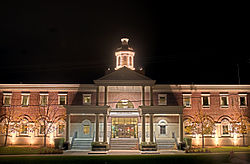Plainfield, IL
| Plainfield | |
|---|---|
| Village | |
| Village of Plainfield | |

Village Hall in Plainfield, Illinois
|
|
 Location of Illinois in the United States |
|
| Coordinates: 41°37′2″N 88°12′10″W / 41.61722°N 88.20278°WCoordinates: 41°37′2″N 88°12′10″W / 41.61722°N 88.20278°W | |
| Country | United States |
| State | Illinois |
| County | Will |
| Township |
Plainfield (Will Co.) Wheatland (Will Co.) Na-Au-Say (Kendall Co.) Oswego (Kendall Co.) |
| Area | |
| • Total | 25.39 sq mi (65.75 km2) |
| • Land | 24.41 sq mi (63.22 km2) |
| • Water | 0.97 sq mi (2.52 km2) |
| Population (2010) | |
| • Total | 39,581 |
| • Estimate (2016) | 42,933 |
| • Density | 1,758.76/sq mi (679.06/km2) |
| Time zone | CST (UTC-6) |
| • Summer (DST) | CDT (UTC-5) |
| ZIP Code(s) | 60544, 60585, 60586 |
| Area code(s) | 815 and 779 |
| FIPS code | 17-60287 |
| Plainfield, Illinois | |
| Website | http://www.plainfield-il.org/ |
Plainfield is a village in Will County, Illinois, United States. The US Census Bureau estimates the population at 41,734 as of 2013.
The village includes land in Plainfield and Wheatland townships. Part of Plainfield is located in Kendall County (Na-Au-Say and Oswego townships). With the growth in the Chicago suburbs in the 1990s and 2000s, the village has seen a population increase, from 4,500 in 1990 to 28,000 in 2000 to more than 37,000 in 2007.
The village has established a community Preservation Commission and historic preservation ordinance. It is the home of the Lake Renwick Preserve, a county forest preserve used for birdwatching and other activities.
The area was called Walkers' Grove until it was platted as Plainfield in 1841. It was originally settled by a large community of Potawatomi, and the land was later bequeathed to the United States as part of the Treaty of St. Louis (1816) with the Council of the Three Fires. Indian Boundary Road aligns with the western border of the tract of land originally ceded.
The earliest Europeans in the area were French fur traders. The first European settler in the area was James Walker, who traveled with his father-in-law, Methodist Reverend Jessie Walker traveled here in 1826 where he established a small mission for the Potawatomi Indians. James Walker, Jesse Walker's son-in-law, traveled with him and became the first European to claim land in the area in 1828.
...
Wikipedia
